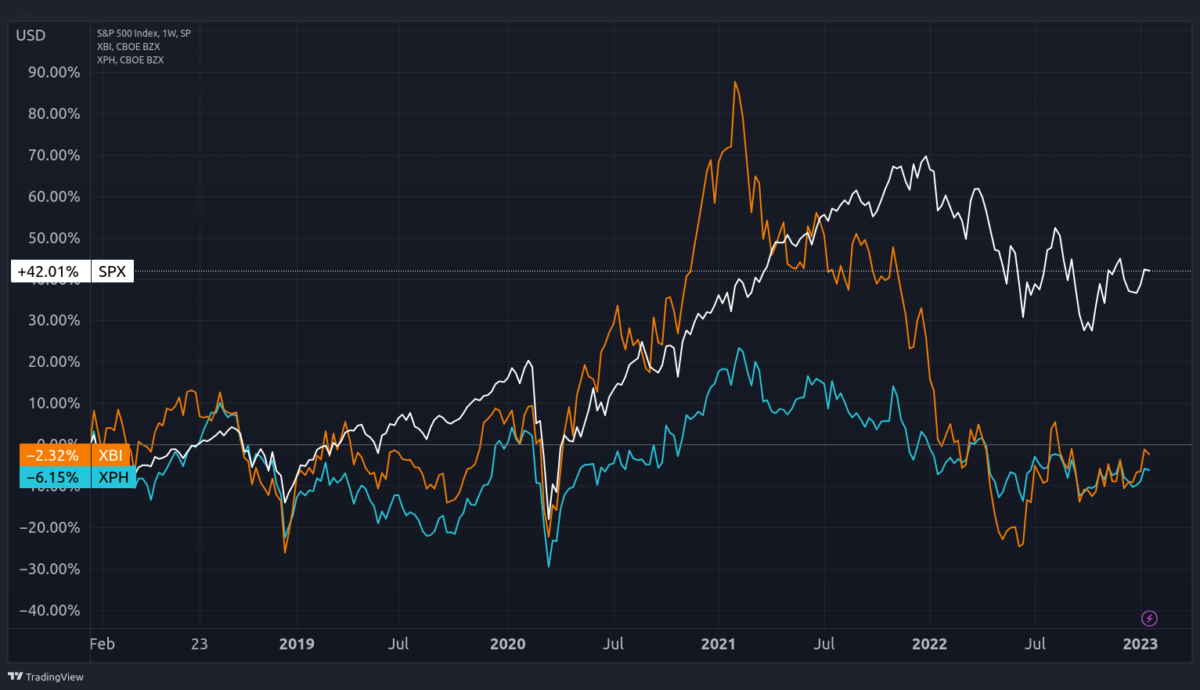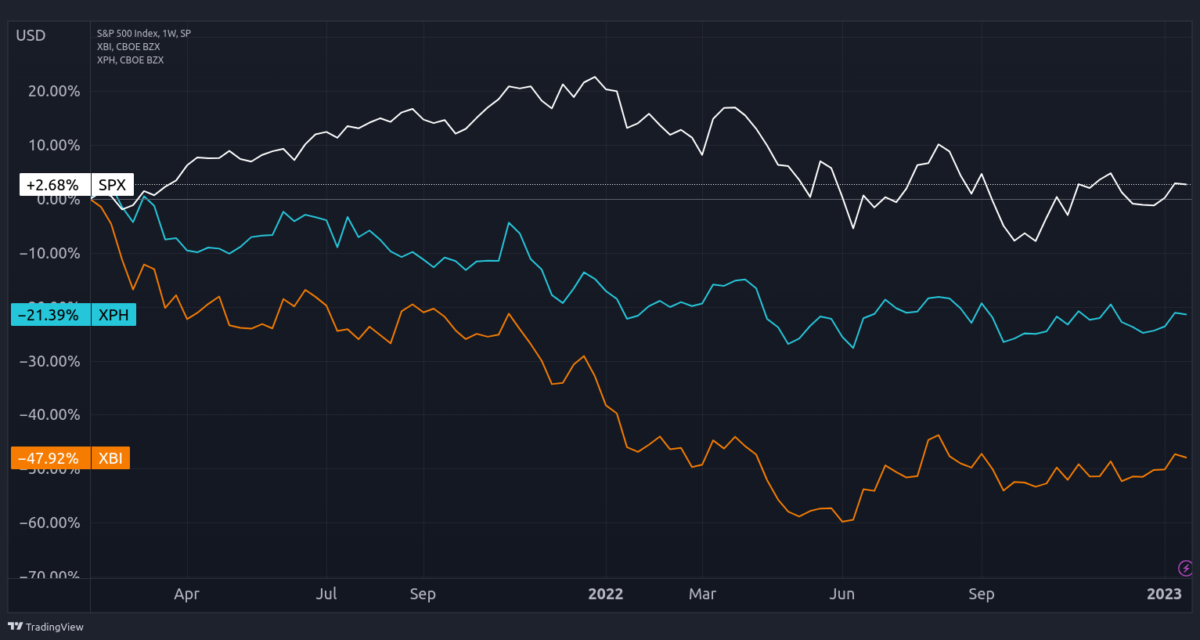Pharmaceuticals and Biotech Are Due For a Rebound

Over the last year, defensive stocks have done very well relative to the broad market. Sectors including Health Care, Utilities and Consumer Staples are among the winners in a market haunted by the fear of a global recession. The rate hikes engendered by the Federal Reserve pushing the funds rate from 0.25% – 0.50% to 4.25% – 4.50%, scared investors away from growth stocks in the direction of value stocks. Tech stocks from the Nasdaq index suffered the most. But even inside defensive sectors like Health Care, there are sub-sectors underperforming. While pharmaceutical stocks declined 7.9% (near half the broad market’s decline), biotech stocks lost almost 19.3% in 2022.
The broad market had a good start this year and both pharmaceuticals and biotech have been rising as well. 2023 will probably be a rough year for stocks because of the potential for a recession, but biotech and pharmaceuticals are due for a rebound. Over the last five years, these industries have been underperforming the broad market. The S&P 500 rose 42%, while pharmaceuticals and biotech declined 6.2% and 2.3%, respectively. This situation is depicted in the chart below, where the SPDR sub-sector indexes XPH and XBI represent the pharmaceuticals and biotech industries, respectively.

During the COVID-19 pandemic, biotech stocks benefitted from increased demand for vaccines and related treatments. Some of the companies, like Moderna, had never seen profits, but they were suddenly boosted by a nascent demand for their products. Moderna’s stock price rose from $20 to $400. In the chart above, we can easily identify a top for XBI in February 2021. Too much optimism boosted biotech stock prices. But the downtrend that followed wasn’t less spectacular. The chart below zooms in on the period starting in February 2021 to provide a better picture of what happened since. It shows how badly both biotech and pharmaceutical stocks have been doing for these last two years.

While the S&P 500 is roughly flat, pharmaceuticals and biotech are down 21% and 48%, respectively.
The impact of interest rates on growth
To a large extent, the decline in biotech is related to the previous uptrend. A COVID-induced demand for vaccines and related treatments increased optimism about biotech companies, boosting their stock prices. But, when the optimism faded due to a realignment of priorities away from the pandemic and healthcare issues, the sector was battered down heavily. However, the downtrend is also the result of rising interest rates. Biotech companies rely heavily on debt financing to fund their research and development expenses. It could be years (or even more than a decade) until reaching the point of selling something. Rising interest rates put a heavy burden on their finances, make them more likely to go out of business, and reduce the cash flow expected in the future. As a result, stock prices decline.
Pharmaceutical companies had a better fate because they are larger than biotech companies, and they rely on established businesses, already generating substantial cash flows. If we take the duration concept from bonds, we could say that pharmaceutical stocks have a lower duration than biotech stocks and are therefore less sensitive to interest rate changes. This feature explains why pharmaceutical stocks have been outperforming biotech lately.
European biotech and pharmaceutical stocks have been performing better than their US counterparts because the rate increases in Europe have been milder than in the US. However, with interest rates now at 4.5% in the US, I expect the Federal Reserve to slow down its tightening pace. As interest rates stabilise, the Biotech sector will recover faster than the broad market. Besides, while the pandemic provided temporary relief to the sub-sector through vaccine demand, biotech is not only about vaccines. Many of these companies are deeply involved in the treatment of major diseases like cancer and Alzheimer. The pandemic boosted the development of new treatments and therapies that may have broader uses.
Where to invest?
To build a diversified portfolio of biotech and/or pharmaceutical stocks, the best option is to use ETFs. There are many ETFs targeting these sub-sectors. I’m selecting six, four dedicated to biotech and two dedicated to pharmaceuticals.
iShares Biotechnology ETF (NASDAQ:IBB)
The iShares Nasdaq Biotechnology ETF (IBB) tracks the performance of the NASDAQ Biotechnology Index, by investing in 275 stocks. This is a well established ETF with a record longer than 20 years. It’s a good option for investors concerned with diversification.
Holdings: 275Inception: 2001Expense ratio: 0.44%Top holdings: Gilead, Amgen, Vertex, Regeneron, Moderna
SPDR S&P Biotech ETF (NYSE:XBI)
The SPDR S&P Biotech ETF (XBI) tracks the performance of the S&P Biotechnology Select Industry Index. This ETF holds a diverse portfolio of companies involved in the biotech and pharmaceutical industries, currently including 155 stocks. The SPDR ETFs track the S&P subdivisions of the whole market into sectors. As such, investing in this fund is the closest an investor can be to holding a US biotech sector portfolio.
Holdings: 155Inception: 2006Expense ratio: 0.35%Top holdings: Madrigal, Exact Sciences, Catalyst, TG Therapeutics, Acadia
VanEck Biotech ETF (NASDAQ:BBH)
I always look into VanEck’s offer because I believe the company to be one of the best ETF providers (if not the best). In comparison to BlackRock’s offer (through the iShares funds), VanEck is usually cheaper.
The VanEck Vectors Biotech ETF (BBH) tracks the performance of the MVIS US Listed Biotech 25 Index, therefore investing in just 25 stocks. It’s a more concentrated bet on biotech than IBB and XBI and 13% of its holdings are held in companies headquartered outside the US.
Holdings: 25Inception: 2011Expense ratio: 0.35%Top holdings: Amgen, Gilead, Vertex, Moderna, Regeneron
Global X Genomics & Biotechnology ETF (NASDAQ:GNOM)
For a different option, I would like to mention the GlobalX Genomics & Biotechnology ETF (GNOM). It invests in companies involved in the field of genomic science. This includes activities like gene editing, genomic sequencing, genetic medicine/therapy, computational genomics, and biotechnology. GNOM invests 20% of its funds outside the US. This is a more recent, less diversified and more expensive ETF than the above three. Notwithstanding, it has its own merits.
Holdings: 40Inception: 2019Expense ratio: 0.50%Top holdings: 10X Genomics, Genscript Biotech, Biomarin, Alnylam, Sarepta
PPH – VanEck Pharmaceutical ETF
For a targeted bet in the pharmaceutical sector with 38% of the funds invested outside the US, investors have the VanEck Pharmaceutical ETF (PPH). This is a large cap portfolio targeting the largest market caps in the sector.
Holdings: 25Inception: 2011Expense ratio: 0.35%Top holdings: Johnson & Johnson, Abbvie, Eli Lilly, Merck & Co, Novo Nordisk
XPH – SPDR S&P Pharmaceutical ETF
Investors seeking for a pure sector bet, the SPDR S&P Pharmaceutical ETF (XPH) is eventually the best option. This ETF represents the same as XBI but for the pharmaceutical industry.
Holdings: 40Inception: 2006Expense ratio: 0.35%Top holdings: Revance Therapeutics, Organon, Perrigo, Catalent, Viatris
Final words
In conclusion, I believe that biotech and pharmaceutical stocks are poised for growth in the near future. Both sub-sectors of Health Care have underperformed the broad market for the last five years, and they are due for a rebound. While interest rates may dent growth stocks, which largely include biotech stocks, the majority of the negative effects have already been felt in the industry. Investors should consider adding these stocks to their portfolios as they may offer strong returns in the coming months.
Comments (0)